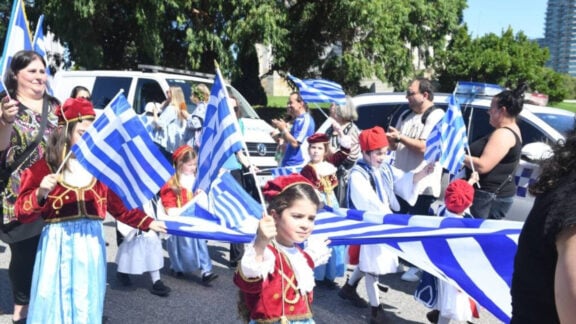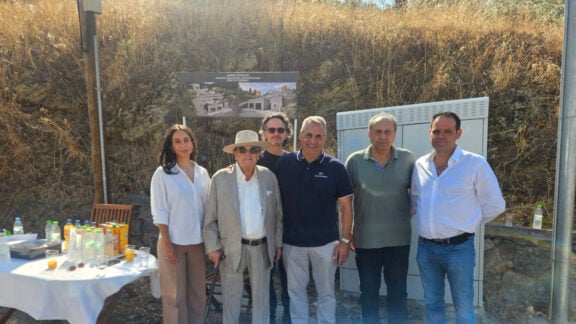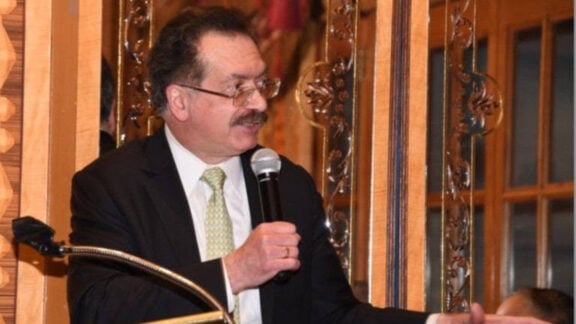Discussions held in Greece’s second city – Thessaloniki – have advanced the Australian community proposal to have a commemorative plaque installed at the site of the former German-run Allied POW camp that operated there at the end of the Greek campaign of 1941.
Ms Litsa Athanasiadis of Melbourne’s Merimna and Pontiaki Estia community organisations and myself recently had the honour to discuss the Anzac Trail in Greece with the Mayor of Thessaloniki, Mr Konstantinos Zervas. The Mayor interrupted his busy schedule to hold the meeting.
We outlined the long and deep connection between Australia and Thessaloniki and its surrounding hinterland. This stretches back to the Salonika campaign of the First World War, in which hundreds of Australian service personnel served and one Australian nurse died, Ballarat’s Gertude Munro, who is buried in Mikra War Cemetery which lies to the east of the city. This association with Victoria’s regional city of Ballarat continued in the substantial assistance provided by Ballarat’s Major George Devine Treloar in the re-settlement of over 100,000 Christian refugees during and following the Asia Minor Catastrophe in the early 1920s.
During the Second World War and the occupation of Thessaloniki following the end of the Greek campaign of 1941, thousands of Australian and other Allied soldiers captured in the campaign were brought to Thessaloniki where they were held – for weeks or months – in a hastily organised POW camp. The site of a former Ottoman barracks and abandoned Greek army camp, the terrible conditions there would live in the memories of the prisoners as a “hell camp.”

Many prisoners died, with thousands being sick and debilitated. Many also escaped into the city where they were helped by brave locals, assisting them to survive and ultimately to make their way back to Allied lines in the Middle East. My researches on the POW camp story has drawn not only on archives and POW memoirs but was also assisted by the Thessaloniki War Museum, where the camp was located.
Ms Athanasiadis explained the work of the Pontiaki Estia, drawing on the research of myself and with the financial support of a number of other community organisations and individuals, in commemorating the refugee work of Major Treloar with the erection of the Treloar Memorial in Ballarat in 2019. She took the opportunity to present the Mayor with a copy of the Treloar Memorial booklet, DVD and Treloar commemorative badge.
I explained the work of the Anzac Trail in Greece Coordinating Committee, formed in Melbourne in 2018, which aims to create an Anzac Trail across Greece linking the significant locations connected with the service of Australian military personnel across both world wars. The recent Australian Government decision to fund the creation of a new Remembrance Trail on the northern Aegean Island of Lemnos commemorating its role in the Gallipoli campaign is a key new initiative in his respect.
Along with the locations connecting Australia and Greece through both the role of Lemnos and the Salonika campaign in the First World War, the substantial Australian involvement (alongside the other Allied forces) in the Greek campaign of 1941 links site across mainland Greece and on to Crete. I explained how four new commemorative plaques will soon be installed across the Peloponnese – with two at Corinth as well as one each at Kalamata and Trahila in the Mani – honouring little appreciated but major events in that campaign. These will join with other existing memorials, such as those at Vevi, Brallos Pass, Phaleron, 42nd Street, Rethymno, Sfakia and Suda Bay (as well as the post-campaign memorials at Pylos and Methoni) to name only a few – together forming an Anzac Trail.
The proposal is that Thessaloniki takes its part in this Anzac Trail with the commemoration of Thessaloniki’s German-run POW camp. The plaque will be researched and created in Melbourne and installed at the site of the former camp by the Thessaloniki municipality. This will be a place for annual reflection, possibly a commemorative service, and will aid those locals and visitors – including veterans families – seeking to honour the service of those kept prisoner there, those that escaped and those who helped them. Work has begun in the researching of an appropriate plaque, which will be created over coming months.
The proposed new commemorative plaque will join with Thessaloniki’s impressive existing WW2 memorials – from its moving Holocaust memorials, the anti-fascist memorial to the resistance, to the city’s liberation and that to the important role of women in the resistance to the 1940 Italian invasion. Ms Athanasiadis and myself visited these memorials during our visit to the city.
The Mayor expressed his appreciation for the proposal, noting that honouring the prisoners held there, those that escaped and the local population who assisted them recognises an important part of Thessaloniki’s history. He said that the realisation of the proposal will also deepen the already strong connection between Australia and the city, with the formers large diaspora from Thessaloniki and the Sister-City relationship Melbourne.

We also took the opportunity to present the Mayor with a copy of the recently published Grecian Adventure, whose publication was assisted by the Pontiaki Estia. A key chapter of the book details the story of the POW camp, how it impacted on the city and some of the various escape attempts made by its inmates, especially Frankston’s Lance Corporal Dudley “Skip” Welsh of the 2/6th Australian Infantry Battalion.
The meeting expressed the desire to work together on this important proposal, which will not only commemorate the story of the POW camp but will add to Thessaloniki’s rich history and encourage increased visitation from Australia. We all looked forward to the creation and installation of this new commemorative plaque.
The meeting was one of a number held in recent weeks with various municipalities and regional authorities in Greece to advance the installation of the four new Anzac trail commemorative plaques mentioned – all of which are supported by a number of Melbourne-based Greek community organisations keen to support this action to increase awareness of the Hellenic link to Australia’s Anzac story through this new Trail.

Jim Claven is a trained historian, freelance writer and published author. His recent publications on the Hellenic link to Anzac include Lemnos & Gallipoli Revealed and Grecian Adventure. He was also a contributor to the Australian Embassy in Greece’s commemorative publication Mates and Allies. He is Secretary of the Lemnos Gallipoli Commemorative Committee, Coordinator of the Anzac Trail in Greece Coordinating Committee and a member of the George Treloar Memorial Committee. He was also a historical consultant to the Australian Government’s Lemnos Remembrance Trail project. He can be contacted via email – jimclaven@yahoo.com.au









